|
|
|
THE BILL CHARLAP TRIO
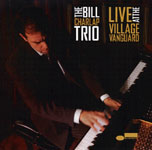 Live
at the Village Vanguard Live
at the Village Vanguard
Blue Note Records
By Tom Ineck
Bill Charlap’s first live recording is long overdue. The trio of
pianist Charlap, bassist Peter Washington and drummer Kenny
Washington is one of the great threesomes of modern jazz
history, and this release finally makes that unmistakably clear.
Taped nearly four years ago, in September 2003 at the famed jazz
club in lower Manhattan, the performance is a faithful document
of the Charlap trio at its finest. Already together for several
years at the time of this recording, the trio works its magic on
a set of nine tunes, carefully chosen for their melodic and
harmonic potential.
Gerry Mulligan’s uptempo “Rocker,” best known for its inclusion
in Miles Davis’ “Birth of the Cool” sessions, is an excellent
opportunity for the trio to flex their musical muscles. The
timely ballad “Autumn in New York” gets an absolutely gorgeous,
restrained reading, exemplifying the trio’s measured gait and
mutual sensitivity. As performed by the trio, it is an
emotionally devastating expression of the turning of the
seasons, but also of aging, lost love and wistful regret.
Returning to the “Birth of the Cool” songbook, the trio essays
the rhythmically challenging “Godchild” by George Wallington.
Aided and abetted by a driving bass line and sizzling brushwork
on the snare drum, Charlap turns in a dazzling piano foray. It’s
back to ballad tempo for “It’s Only a Paper Moon,” which is
taken at a snail’s pace, allowing Charlap to ruminate and pause
and generally “feel” his way through the changes, adding bluesy
flourishes and unexpected modulations. He always remains true to
the original melody and always seems to choose the perfect
harmonic variations.
On
the other hand, it is not unusual for Charlap to choose a tempo
that defies convention—and sheer technical capability. Such is
the case on “My Shining Hour,” taken at a headlong,
mind-boggling pace. It is a workout for all. After Charlap
states the melody and soars through variations, Peter Washington
leaps through the changes and Kenny Washington keeps time with
rim shots before taking an astounding solo of his own.
The
tempo shifts downward again for Jim Hall’s lovely ballad “All
Across the City,” an underappreciated gem which was most notably
covered in versions by pianist Bill Evans and alto saxophonist
Paul Desmond. Charlap caresses the keys, emphasizing the beauty
of each chord change with tender, often dissonant harmonic
touches as bassist and drummer offer subdued support.
“While We’re Young,” by Alec Wilder, is taken at a fast waltz
tempo that aptly inspires all to freewheeling displays of
playful experimentation. Harold Arlen’s “Last Night When We Were
Young” closes the performance on another wistful note,
reverberating with faded memories of youthful passions and hints
of regret.
top |
|
|
|
TOWNER GALAHER
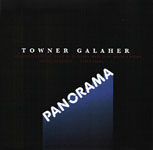 Panorama Panorama
Towner Galaher Music
By Tom Ineck
In
his debut recording as a leader, drummer Towner Galaher fronts a
classic hard-bop quintet, often in the style of Art Blakey’s
hard-driving Jazz Messengers. But this outfit also is capable of
more subtle performances.
Galaher penned all but three of the eight tunes. The opener,
“Midtown Shuffle, is a swaggering workout for the band, which
also consists of relative veterans Onaje Allen Gumbs on piano,
Charles Fambrough on bass and Mark Shim on tenor sax, as well as
the young trumpeter Maurice Brown. Their take on “Have You Met
Miss Jones?” delves into the Latin mood, with added percussion
by Johnny Almendra and Frank Colon.
“I’m All Smiles” is a breezy jazz waltz with outstanding
contributions by Gumbs, a master of harmonic variations, and
Shim, whose solo brilliantly weaves a sound tapestry around the
changes. On “Legba,” Galaher taps into a funky, New
Orleans-style beat that inspires Brown to a heated trumpet solo,
and a brief interlude by the percussionists leads into a
smoldering tenor solo by Shim, all in less than four minutes.
Indeed, there is an economy of scale throughout this session,
with most tracks clocking in at around five or six minutes.
Galaher drives the title track with a sharp, crackling drum
attack and well-timed cymbal flourishes. Shim turns in another
blustery tenor solo. “Goodbye Pork Pie Hat,” the classic Charles
Mingus threnody to Lester Young, begins with a nice
plunger-muted trumpet statement before Shim states the familiar
melody on tenor. But it is Gumbs whose lovely piano solo
captures the essence of this heart-wrenching ballad.
Fambrough delivers some ominous walking bass lines on
“Charisma,” which also features another well-constructed Shim
solo and a searching, bluesy solo by Gumbs. “East 104th
St.” is an urban, hard-bop burner in the Blakey mold, but under
Galaher’s direction it is given a Latin flair with added
percussion and fiery solos by Shim and Brown. “Panorama” is an
impressive debut that establishes Galaher and company as an
exciting and formidable hard-bop ensemble.
top |
|
|
|
THE STRYKER/SLAGLE BAND
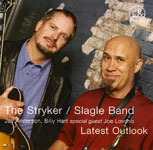 Latest
Outlook Latest
Outlook
Zoho Music
By Tom Ineck
Aptly titled, “Latest Outlook” is a state-of-the-art excursion
in playing “outside” the changes. It challenges the listener to
imagine the alternatives, the unexpected and the unconventional.
Its insistence on avoiding the easy resolution may be agonizing
to some ears. The trick, as with all progressive jazz
experiences, is to abandon your preconceptions and go with the
flow.
Under those conditions, “Latest Outlook” is a joyous
rollercoaster ride, commandeered by co-leaders and longtime
colleagues Dave Stryker on guitar and Steve Slagle on alto and
soprano saxes. Also along for the ride are bassist Jay Anderson
and legendary drummer Billy Hart. The quartet maintains
clockwork compatibility, regardless of odd time signatures or
that confounded irresolution.
Slagle’s tunes are especially compelling. The opener, “Knew
Hold,” has Slagle and Stryker pairing up on the complex changes
in unison. Anderson keeps the ominously pulsing time while Hart
ranges far and wide over the drum kit, a true percussionist.
Likewise on the funky title track, another Slagle composition,
the leaders state the odd melody in tandem before the composer
is set loose to explore solo variations. Stryker’s solo deftly
alternates between chords and single-note runs. Hart makes a sly
reference to James Brown in his tight solo.
Tenor saxophonist Joe Lovano appears on two tracks, including
the Charlie Parker tribute “Bird Flew,” based on the changes to
“Confirmation.” As always, Lovano digs in with gusto, urging on
everyone else in the band, especially Hart. The wordplay of
Stryker’s “Hartland,” refers not only to the drummer but to the
composer’s Nebraska home. Its open feel is achieved rhythmically
by Stryker on steel-stringed acoustic guitar with Anderson and
Slagle, on soprano, jointly stating the breezy theme. Stryker
switches to electric guitar for a solo on what is the most
accessible and tuneful tune on the session.
The
centerpiece of the entire project, however, is “Dear Mr. Hicks,”
Slagle’s memorial to the late pianist John Hicks. Stretching to
nearly 12 minutes, its opening elegiac mood quickly shifts to
swing time. Lovano returns with an extended, soulful flight on
the bluesy changes, as Stryker expertly comps in chiming rhythm.
The guitarist’s own brief solo is inspired.
Charles Mingus’ “Self-Portrait in Three Colors” is the sole
ballad and sole “cover tune,” an appropriate choice considering
Slagle’s long association with the Mingus Big Band. Stryker and
Slagle handle the beautiful interweaving lines with grace and
soul. Stryker’s “Turning Point” features some nice Wes
Montgomery-style chording and is a wonderful vehicle for Hart’s
shimmering cymbal work, Slagle’s plaintive alto and Anderson’s
lyrical and resonant solo. It is perhaps the ultimate example of
how well this quartet works together. The CD ends with the
uptempo romp “In Just Time,” another clever updating of a
standard. In this case “Just in Time” is not just “outside” but
inside out.
top |
|
|
|
NORDIC CONNECT
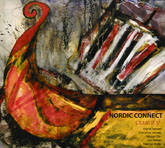 Flurry Flurry
ArtistShare Records
By Tom Ineck
In
an attempt to explain the group concept of Nordic Connect in the
liner notes of the ensemble’s debut recording, “Flurry,”
trumpeter Ingrid Jensen whimsically says, “We are fair-skinned,
blond and tall (some of us) and very much into good cheese and
‘happy-sad’ music that invokes the many influences we have all
had in our lives.”
Well, Nordic Connect is more than that. Personally, it is a
group spirit that draws on elements of family and protection
from the often-cold world beyond the hearth. It is an expression
of camaraderie, the kind of group empathy that is achieved only
be giving as much as receiving. Jazz is a sharing enterprise and
Nordic Connect is a group of musicians who share a worldview and
a musical vision.
The
Nordic mix consists of Ingrid Jensen and her sister, saxophonist
Christine Jensen—Canadians of Danish ancestry—joined by Swedes
Maggi Olin on keyboards and Mattias Welin on bass and
Alaskan-born Norwegian Jon Wikan on drums and percussion.
While there is some truth to the stereotype that Nordic or north
European music is cerebral or devoid of soul or “warmth,” Nordic
Connect belies the conventional truth with passionate playing
and intense group interplay. The opening title track by Olin
bears this out with alternating passages of introspection and
surging energy. The Jensen sisters are especially effective in
their duo statements. Christine Jensen’s gentle “Sweet Adelphi,”
with the composer on soprano sax, also showcases Welin on an
extended solo and Olin creating a luscious understated keyboard
tapestry.
Ingrid Jensen’s slow-building “Things I Love” delves into her
fusion side, with Harmon-muted trumpet, electric piano and funky
backbeat reminiscent of later-period Miles Davis. The tune
eventually opens up as Jensen switches to flugelhorn and sister
Christine ups the ante with a brooding alto sax solo. The rhythm
section of Welin and Wikan prove their sensitivity and expertise
as the tempo continually shifts and slides on Olin’s “Sweet
Dream.”
Perhaps the most lovely and accessible tune here is Christine
Jensen’s “Garden Hour,” a lovely three-minute ballad featuring
the Jensens going head-to-head on the stately folk-like melody.
Ingrid Jensen’s “Seascape” is a brief, but tender melodic
statement that acts as an introduction to her sister’s
composition “Seafever.” Olin again acts as perfect harmonic foil
to the two sisters’ brass interplay. Here and elsewhere, Wikan
employs a unique “clip-clopping” technique in his timekeeping.
“Cowboy” gallops along at a furious pace, aided by Olin on
electronic keys, multi-percussionist Wikan and Ingrid Jensen
turning up the trumpet’s electronic effects. Composer Olin sets
up the 11-minute “Breathe/Quadr” with a haunting introduction
utilizing repeated notes and a shifting tempo. The front-line
horns breathe as one until Christine Jensen steps forward for a
measured solo statement on sax. Olin contributes another great
piano solo before turning it over to Ingrid Jensen for a
flugelhorn solo. Eventually, as if by natural osmosis, the
quintet reunites for the theme and conclusion.
Seven of the nine tracks go beyond seven minutes and three
tracks extend to nine minutes or more, so everyone in the
quintet is given room to express their ideas and “connect” with
the others. All three women prove to be exemplary composers,
again emphasizing the shared nature of this project.
top |
|
|
|
ED REED
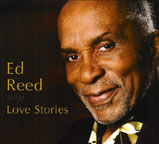 Ed
Reed Sings Love Stories Ed
Reed Sings Love Stories
Blue Shorts Records
By Tom Ineck
On
hearing “Ed Reed Sings Love Stories” for the first time is, a
listener’s most appropriate response is, “Where the heck has
this guy been all these years?”
Even jazz singer Sheila Jordan exclaims, “Where have you been
hiding Ed Reed? The whole jazz world needs to hear you.” Well,
like so many talented black artists who grew up urban America in
the 1930s and 1940s, Reed encountered social barriers, drifted
into drug use and heroin addiction, and eventually served
several terms in prison, in Reed’s case San Quentin and Folsom.
A
native of southern California, Reed sang with saxophonist Art
Pepper while in prison and with saxophonist Dexter Gordon,
trumpeter Art Farmer, pianist Hampton Hawes and saxophonist
Wardell Gray in “open mike” situations while he was out. After
40 years of addiction, he finally began a successful recovery
program in 1986. With this debut recording, Reed finally
declares his liberation.
Reed’s reedy voice has an impressive range and is especially
effective in the bass-baritone register, which he exhibits to
good effect on “Bye Bye Blackbird.” He is capable of some nice
vibrato and passages of extended phrasing on tunes like “A
Sleepin’ Bee” and the Gordon Jenkins weeper “Goodbye.” Tonally,
he is sometimes reminiscent of trumpeter-singer Jack Sheldon,
especially when he goes for the upper registers. The two also
are similar in their horn-like quality.
Lending very sensitive support is the backing rhythm section of
pianist Gary Fisher, bassist John Wiitala and drummer Eddie
Marshall. Most of all, the very versatile Peck Almond
contributes a host of instrumental flavoring on trumpet, tenor
sax, flute, alto flute, clarinet, bass clarinet, trombonium and
kalimbas.
The
songlist is largely comprised of tried-and-true romantic
standards, most of them taken at a relaxed ballad tempo,
including “Ghost of a Chance,” “A Flower is a Lovesome Thing,”
“Where Do You Start,” and “Daydream.”
Less well known but equally effective are Thelonious Monk’s “Ask
Me Now,” with lyrics by Jon Hendricks, and “If the Moon Turns
Green.” An apt closer is the folk and gospel classic “Motherless
Child,” which Reed sings a cappella with great conviction.
Reed deserves to be heard, and perhaps with “Ed Reed Sings Love
Stories” he will begin to receive that long-delayed recognition.
top |
|
|
|
FRANCOIS INGOLD TRIO
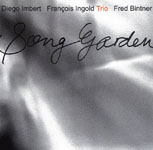 Song
Garden Song
Garden
Altrisuoni Records
By Tom Ineck
“Song Garden,” the recent debut by 30-year-old Swiss pianist
Francois Ingold, further extends the impressionist keyboard
school founded by Bill Evans and later developed by Keith
Jarrett, Fred Hersch, Ivan Paduart, Brad Mehldau and others. It
is poetry in motion, truly a “garden” of colorful musical
delights.
Like the others mentioned above, Ingold excels in the trio
format, here with bassist Diego Imbert and drummer Fred Bintner.
Recorded last year in France and mastered in Switzerland, “Song
Garden” reverberates with European romanticism, especially on
the gentle “Children’s Song (To Denis)” and “Love Song.”
Even “Premiere Dent,” with its pulsing Latin rhythm and brief
drum solo, maintains its stateliness in Ingold’s flowing lines
and Imbert’s subtle accompaniment. The bassist steps out a bit
more on the lyrical “Il n’y a pas de’amour heureux,” by Georges
Brassens, a popular French singer-songwriter who died in 1981.
Imbert provides a beautiful bass counterpoint to Ingold’s
keyboard flights.
Ingold composed five of the eight tracks. “Black Trombone” is a
haunting tune by French composer and cult figure Serge
Gainsbourg. But, undoubtedly, the oddest choice here is “A
Forest,” a 1980 hit by the British rockers The Cure. Like
Mehldau, Ingold is capable of provocatively transforming a
familiar pop tune while remaining true to its spirit. He
repeatedly states the theme and creates dark variations, with
Bintner eventually escalating to some rock drumming
pyrotechnics.
The
apt closer, “Hymne au Revoir,” is a gorgeous ballad of farewell
that again places Ingold solidly in the romantic camp of Evans
and his spiritual descendants. We hope the Francois Ingold Trio
does not stay away too long.
Actually, “Hymne” is not the end of “Song Garden,” which after a
couple minutes of silence contains a hidden track with the most
animated playing on the entire recording. It has a Monkish
flavor and features some very uninhibited drumming by Bintner.
top |
|
|
|
MIKE FREEMAN ZONA VIBE
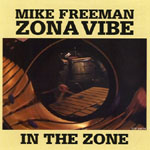 In
the Zone In
the Zone
VOF Recordings
By Tom Ineck
Omaha native Mike Freeman, now living in New York City, is a
competent vibe player who has gathered some like-minded
musicians under the banner of Zona Vibe for his latest release,
“In the Zone,” under his own VOF Recordings moniker.
“In
the Zone” has a distinctly Latin groove, aided by Ricardo
Rodriguez on bass, Little Johnny Rivero on congas, Harry Adorno
on timbales and Bruce Saunders occasionally joining in on
guitars. There is little that is challenging or new here, from
“Mr. 2000” to “There Ya Go” to “Horse’s Run” and “A Las Seis,”
but the melodies are pleasant and it is all played with a light
swinging feel that shouldn’t offend anyone.
As
the only other soloist, Saunders does manage to infuse the
proceedings with some soul, especially on “Cha Cha Mama,” “Red
Thunder” and “Afriman.” He also adds sonic depth by doubling
some of the melody lines with Freeman’s vibes.
Freeman briefly evokes the blues during a solo on the lovely
“The Fallen,” and his switch to marimba on the Peruvian standard
“Todos Vuelven” is a nice change, but his playing generally
lacks the kind of soulfulness and risk-taking that makes the
best jazz so exciting and unpredictable.
top |
|
|
|
THE BOULEVARD BIG BAND
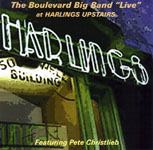 “Live”
at Harlings Upstairs “Live”
at Harlings Upstairs
BRC Music Productions
By Tom Ineck
Nineteen years on, the Kansas City-based Boulevard Big Band has
released a live recording at Harlings Upstairs lounge that
admirably captures the excitement of big-band performance,
though the recording quality is uneven.
Like the band’s 2004 Sea Breeze release “Take Only for Pain,”
the new CD features tenor saxophonist Pete Christlieb, a
longtime first-call soloist from Southern California.
Christlieb’s thoroughly professional style and burly, burnished
tone are definite assets. Whenever he enters the fray, such as
on the opener, “Peeve,” Wayne Shorter’s “Black Nile,” and the
closer, “It’s Not About You,” the temperature noticeably rises.
He also turns in stellar performances on Bobby Troupe’s ballad
“The Meaning of the Blues” and McCoy Tyner’s “The Search for
Peace.”
Irving Berlin’s “Cheek to Cheek,” arranged by Hal Melia, is
taken at a breakneck speed, but the arranger’s lively alto
saxophone solo is virtually buried in the mix. Other standout
musicians who help keep the kettle boiling are trombonist Paul
McKee on “Black Nile,” flugelhornist Jay Sollenberger on “If I
Only Had a Brain,” trombonist Steve Dekker on Lou Marini’s funky
“Alone,” trumpeter Dave Aaberg on “It’s Not About You,” and
members of the rhythm section, especially drummer Todd Strait
and bassist Tim Brewer. The contributions of pianist Roger
Wilder and guitarist Rob Whitsit are nearly undetectable by the
human ear.
Throughout the show, stage announcements and audience response
suffer from poor miking, creating the impression that the
performance got a lukewarm reception. Also, the cover design is
horrid, with dimly lighted photos of Harlings interior, tiny
reverse-printed liner notes and difficult-to-read track
information printed in black against a dark photograph of the
band.
The
listener who can disregard the many shortcomings, however, will
be rewarded with a solid performance by Kansas City’s veteran
big band.
top |
|
|
|
PHIL DEGREG TRIO
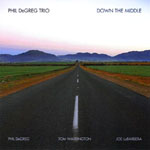 Down
the Middle Down
the Middle
Prevenient Music
By Butch Berman
Every one who knows me accepts my baseball mania. In the big
leagues, almost every team has at least one “star”
player. However, to make it to the World Series, you need the
sum of the parts of all his teammates, as each “utility” player
becomes equally important, but not necessarily “famous.” The
same seems to be true in the world of jazz.
I’m
listening to the always-stunning piano work of Phil DeGreg’s
newest CD, "Down the Middle," while I write this review and
think to myself, "This is his 10th recording, all
excellent, and it seems only the 'ones in the know' truly know
who this genius is."
If
you’re from Cincinnati and heard Phil’s ultra-sophisticated
brilliance at the famed jazz club, the Blue Wisp, for the last
13 years, or while studying under him at the University of
Cincinnati Conservatory of Music, you probably think of him as
the second coming of Bill Evans. Ask any of the greats Phil’s
played with, such as trumpeter Claudio Roditi or saxophonist
Greg Abate or drummer Todd Strait, to name just a few, and
they’ll all tell ya the same. Phil’s a true gentleman and a
complete monster of a player.
I
first met him when he was on the staff of Jamey Aebersold’s jazz
camp workshop near Chicago that I attended about the time I
first started my Berman Music Foundation in 1995. I was so taken
by his teaching abilities, his kind demeanor and, of course, his
amazing chops that I hired him on the spot for one of our first
concerts here in Lincoln, Neb., and a few times and locations
since.
This new Prevenient Music release showcases the piano trio
format backing Phil with two of the best in the biz. Drummer Joe
LaBarbera, formally with Bill Evans and Tony Bennett, has always
been one of my faves with his sparkling, crackling driving
style. Add L.A.’s Tom Warrington’s delicate, astute bass lines
to the mix to provide the perfect rhythm section for the
beautiful outpourings from Mr. DeGreg.
Phil composed four intriguing tunes along with some delightful
choices from a variety of other jazz artists, including Diz’s
”Con Alma,” Jerome Kern’s “Pick Yourself Up,” and a rare Jobim
number called “Bonita,” which gives his fans a full display of
all the different elements that Phil possesses and performs with
such elegance, grace and, when needed, unbridled power. I’ve
been lucky enough to have heard many great piano trios over the
years, both live and on records. The Phil DeGreg Trio is one of
them, and one of the best.
Available at CDbaby.com, I’d advise you to grab "Down the
Middle" in a flash, and grab a few for your other jazz friends
while you’re at it. Also, if you’re a player yourself, you’d do
yourself a favor to read Phil’s wonderful jazz textbook entitled
"Jazz Keyboard Harmony" and perhaps I’ll be reviewing your CD
someday, as well.
top |
|
|
|
TERAESA VINSON WITH TOM DEMPSEY
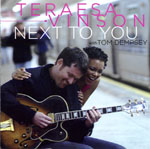 Next
to You Next
to You
AMP 102
By Butch Berman
When I visited New York City a few years ago, I visited Lou
Holtzman, the best “ears” in the recording biz, at his new,
incredible Eastside Sound. That day Lou was recording the first
CD for a new female vocalist named Teraesa Vinson.
She and her hand-picked band of some of the Big Apple’s best,
young lions put out a fine album entitled “Opportunity Please
Knock” that I was able to help her put out. When she recently
sent her newest offering, “Next To You,” much to my
surprise a duo album, I was a little taken aback. However, upon
the first and second listening to her rich, supple voice, backed
by one of the top young guitarists on the scene today, Tom
Dempsey, I was very much entertained.
Teraesa’s interpretation of a wide, eclectic choice of
songwriters makes this a record for all ears, young and old.
Steve Perry’s “Foolish Heart” and Stevie Wonder’s “Ribbon in the
Sky” somehow fit well into a mix of Jerome Kern and Oscar
Hammerstein, Jobim, and McCoy Tyner standards, to name just a
few.
Dempsey, the other “voice,” is not only a cookin’ guitar player
but a master accompanist with terrific chops. Tom, along with
drummer Dion Parsons creates a CD full of tasty arrangements
that transpose a lot of old favorites into nifty, refreshing
statements that define what jazz is really all about. They even
take a chance reprising the title track from their first
recording effort and give Oscar Brown’s “Opportunity Please
Knock” a whole other identity. I really dig her rendition of Cy
Coleman/Carolyn Leigh’s “My How the Time Goes By,” turning it
into a swell blues number, and a different stab at Johnny
Mercer’s “I Remember You” that also works like a charm.
And speaking of charming, whoever decided to put the lovely Ms.
Vinson in a dynamite pink mini-skirt on the inner sleeve should
be nominated for a Grammy for his or her foresight. Yup, pretty
to look at and a pleasure to hear makes this AMP release a must
for all of us who love hearing a great song sung well, as well
as appreciating one hot guitar picker. Get next to “Next To You”
and feel the love.
top |
|
|
|
KENDRA SHANK
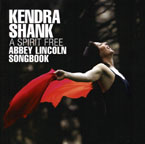 A
Spirit Free: Abbey Lincoln Songbook A
Spirit Free: Abbey Lincoln Songbook
Challenge Records
By Tom Ineck
It
must first be said that any singer who devotes an entire
recording to the idiosyncratic songbook of the great Abbey
Lincoln is either gutsy or downright foolhardy. Lincoln brings
so much of herself to her compositions and performances that it
is difficult to imagine anyone else doing them justice.
Then, along came Kendra Shank. With “A Spirit Free,” she
establishes herself as a bold stylist capable of faithful (and
inspired) interpretations of 11 classic Lincoln tunes, nearly
all drawn from Lincoln’s 1990s Verve recordings. The
performances are combustible, free-flowing affairs fired by the
very compatible crew of pianist Frank Kimbrough, reed virtuoso
Billy Drewes, bassist Dean Johnson, drummer Tony Moreno,
guitarist Ben Monder and Gary Versace on accordion.
Shank deftly navigates the difficult chord changes, unusual time
signatures and shifting dynamics inherent in these pieces. From
the evocative, eight-minute opener, “The Music is the Magic,”
the listener is aware of entering an exotic musical realm, “a
secret world” where “the raging storm” is an everyday
occurrence. Musically, it remains “outside,” floating on a
rhythmic riff without overtly stating the melody.
“I
Got Thunder (and It Rings)” has all the swaggering confidence of
the original performance on 1990’s “The World is Falling Down.”
Shank shifts to a gentle waltz time for “Not to Worry.” Drewes
switches to bass clarinet and Versace joins in on accordion for
the haunting “Down Here Below.” To Lincoln’s “Throw it Away,”
Shank adds her own chanted prelude “Incantation.”
Johnson is Shank’s sole accompanist on “Bird Alone,” and takes a
soaring solo that seems to mimic a bird on the wing.
Appropriately set in a bouncy samba meter, “Wholly Earth”
resounds with the joy of living. “Natas (AKA Playmate)” gets a
playful reading pairing Shank with Versace’s accordion. The
gorgeous ballad “Being Me” is the final track, beautifully
summing up the individuality of Lincoln and, by extension,
Shank.
Kimbrough is a key player here, guiding the others as they
create the perfect atmosphere for each tune. But the true genius
of these tunes is in their lyrical power, memorable lines like
“I pray my soul will find me shining in the morning light,” from
“Down Here Below,” or “The world is falling down, hold my hand,”
written a decade before the collapse of the World Trade Center.
A longtime political activist and astute social observer,
Lincoln yearns for “A Circle of Love” and a world that is
“Wholly Earth.”
Shank's co-producer on the CD, as with the two releases before
it, is Andrew Rowan, a University of Nebraska-Lincoln alumnus
who was active in founding the Lincoln Jazz Society back in the
1970s.
With "A Spirit Free,"
Shank has taken on a monumental task in interpreting Lincoln’s
songs, and she has succeeded admirably. No fool, she is a gutsy
and passionate artist worthy of more recognition.
top |
|
|
|
THE ED PALERMO BIG BAND
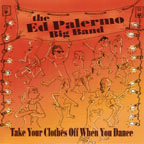 Take
Your Clothes off When You Dance Take
Your Clothes off When You Dance
Cuneiform Records
By Tom Ineck
More than 13 years after the death of Frank Zappa at age 52,
talented and adventurous musicians—with the requisite sense of
humor—continue to mine the hidden gems in his sizable songbook.
Players from the seemingly disparate realms of classical music,
rock and jazz have attempted to do justice to the master. It is
a tribute to the Zappa genius that his complex, idiosyncratic
music inspires interpretations of every stylistic stripe.
Last year’s “Take Your Clothes off When You Dance” is
saxophonist Ed Palermo’s second collection of Zappa tunes in the
big-band format, and it is another grand success, from the
spirited performances to Palermo’s comical liner notes to the
cover cartoon (by Palermo’s sister-in-law) depicting musicians
in the buff, with instruments discreetly positioned. The first
Palermo homage to Zappa, released in 1997, is sadly no longer in
print.
Palermo himself kicks things off on alto sax with the swirling
melody of “RDNZL,” which also features solo statements by
trombonist Charles Gordon, pianist Bob Quaranta, organist Ted
Koosian and drummer Ray Marchica. The whole band joins in on the
stop-time shouts and the affair wraps up with a trademark Count
Basie ending.
The
title track gets a syncopated Latin treatment, perfect for the
circular melody line. Trombonist Joe Fiedler and tenor
saxophonist Ben Kono lend heat with their fiery solos, and
Emedin Rivera adds percussion. “Dwarf Nebula Processional March
and Dward Nebula,” is a distinctly Zappaesque tune of quizzical,
dazzling changes and intense alto sax work by Cliff Lyons.
“Pound for a Brown on the Bus” fuses rock, jazz and classical
motives to create a complex rhythmic journey driven by drummer
Marchina and aided and abetted by soloists Palermo on alto sax,
Koosian on organ and Bill Straub on tenor sax. “Sleep Dirt,”
from the 1979 album of the same name, is sort of like a twisted
ballad, and lends itself well to the jazz treatment here
featuring Phil Chester on soprano sax.
“The Gumbo Variations,” which debuted on the classic 1969 album
“Hot Rats” as an extended jam nearly 17 minutes long, here is
reduced to about six minutes of funky bliss, with solos by Dave
Riekenberg on tenor sax and the fabulous Carl Restivo on wah-wah
guitar, sounding very Zappa-inspired. Restivo also sings the
haunting first half of “Mom and Dad/Oh No,” while most of the
second half is performed as an instrumental with very jazzy alto
sax by Palermo, before Restivo returns to sing the final lyric.
Coming in at over nine minutes, this medley tour de force may be
the brightest gem in the jewel box.
Palermo’s arrangements take advantage of the entire 16-piece
band, as the outfit passes the ball back and forth in typical
Zappa fashion. Dead serious passages often alternate with pure
hilarity.
I
was able to order “Take Your Clothes Off.” online, but unless
Zappa and his music get the widespread support they deserve,
this Palermo recording may soon become as rare as his first. Get
it while you can. Then, grab a dancing partner and take off your
clothes! Frank Zappa would want it that way.
top |
|
|
|
MADELEINE PEYROUX
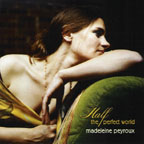 Half
the Perfect World Half
the Perfect World
Rounder Records
By Tom Ineck
On
first hearing Madeleine Peyroux’s 1996 debut “Dreamland,” I
heard a voice for the ages—a bit like Billie Holiday in her
peculiar phrasing and limited range. There was little doubt that
we would hear more from this native of Athens, Ga.
But, as with so many artists in the fickle recording business,
Peyroux was denied a chance to repeat her first success for
eight years, until 2004’s “Careless Love.” In comparatively
little time, we now have her third major label release, last
year’s “Half the Perfect World,” her second on the Rounder
label. She continues to blaze an eclectic trail, melding jazz,
blues, folk and pop influences in a style all her own.
Her
choice of cover material is telling—the title track is by the
weird and wonderful wordsmith Leonard Cohen, who also is
represented by his “Blue Alert.” Peyroux also tapped the sainted
songbooks of Johnny Mercer (“The Summer Wind”), Tom Waits
(“(Looking for) The Heart of Saturday Night”) and Charlie
Chaplin (the timeless “Smile”). “Everybody’s Talkin’,” the Fred
Neil tune of alienation and desperate hope from the film
“Midnight Cowboy,” gets an aptly wistful reading with help from
Sam Yahel on piano, and Peyroux plaintively pairs with k.d. lang
on Joni Mitchell’s classic song of regret, “River.”
Peyroux’s eminently compatible bandmates include guitarist Dean
Parks, bassist David Piltch and drummers Scott Amendola and Jay
Bellerose, in addition to tasteful contributions by Till Bronner
on trumpet, Gary Foster on alto sax, and Larry Goldings on
celeste and Wurlitzer piano. A string quartet is used to good
effect on “Once in a While” and the lovely French waltz “La
Javanaise.”
About eight of the 12 tunes here are ballads, making this great
late-night listening, although the themes tend to be pretty
downbeat, if not downright depressing. On “I’m All Right,”
Peyroux philosophizes: “He got drunk, he fell down, he threw a
few of my things around, but I’m all right, I’m all right, I’ve
been lonely before.” Or, how about this from “Once in a While”:
“Once in a while I’ll wake up, wondering why we gave up, but
once in a while, comes and it fades away.”
After listening to “Half the Perfect World,” you may want to
turn to something a bit sunnier, but in your darker moods
Madeleine Peyroux may seem like the perfect companion.
|
|
|
|
MARK SHERMAN
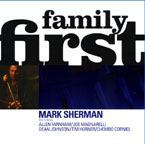 Family
First Family
First
City Hall Records
By Tom Ineck
“Family First” jumps with joy, the kind of spontaneous gaiety
that comes from musicians of like mind who make their music
sound effortless. Vibraphonist Mark Sherman already has proven
himself a top-notch player and leader, with a handful of CDs
under his name in the past decade, including 2005’s marvelous
“One Step Closer,” featuring sax giant Joe Lovano. You can read
a review of that release in the November 2005 BMF newsletter or
click here.
Minus Lovano, Sherman has gathered the same bandmates for his
latest endeavor—trumpeter-flugelhornist Joe Magnarelli, pianist
Allen Farnham, bassist Dean Johnson and drummer Tim Horner, with
conguero Chembo Corneil added on two tracks. Sherman penned half
of the 10 tracks, revealing again his ability to create
play-worthy pieces that never sound alike.
“Explorations,” a tribute to John Coltrane, explores all the
harmonic possibilities with a modulating pedal point over a
driving rhythm. It’s no surprise to learn that “Fantasize” was
influenced by the spirited, melodic music of Pat Metheny. Its
rock rhythms and folk-infused melody conjure the popular fusion
sound of the guitarist without mimicking him. The lilting title
track brims with exuberance, from the opening statement pairing
vibes and flugelhorn to the inventive solo by Farnham and the
solid support of the rhythm section. Horner and Corneil, both on
congas, provide a gentle rhythmic cushion for the ballad “With
Hope,” which also features a definitive flugelhorn solo.
Paquito D’Rivera’s “Wapango” is a perfect vehicle for the band’s
virtuosity and compatibility. They fly through the rapid,
difficult changes with aplomb, generating considerable heat and
excitement in this Afro-Cuban tour de force. “Lazy Autumn,” a
Sherman tune arranged by Farnham, has an appropriately loping,
bluesy mood, and “Symmetrical” reflects its title in a swirling
cycle of changes.
Joe
Henderson’s “Punjab” and the ballad standard “We’ll Be Together
Again” get new, revelatory interpretations, especially the
latter, another brilliant Farnham arrangement. “Family First”
closes with “A New Blue,” Jimmy Heath’s infectious, fresh take
on the blues. The whole band swings mightily on this one.
With most of the performances lasting about five minutes,
Sherman eschews superfluous soloing in favor of tight
arrangements alternating brief solo statements and interesting
harmonic passages for multiple instruments. It is a formula that
works to great advantage and truly makes this outfit seem like a
musical “family” that plays very well together.
top |
|
|
|
JEFF NEWELL’S NEW-TRAD OCTET
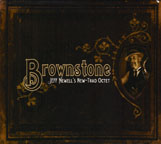 Brownstone Brownstone
Blujazz Productions
By Tom Ineck
Jeff Newell has always had a twisted sense of humor, which is
not to say that he doesn’t take his music seriously. He just
approaches it from a slightly skewed perspective.
So
it is with “Brownstone,” which at times sounds like someone
slipped a tab of LSD into John Philip Sousa’s lemonade. The
truth of the matter is that this music is well grounded in
Newell’s knowledge of post-Civil War history, demographics,
architecture and, of course, music past and present. As he
writes in the liner notes of this attractively packaged CD, “As
our nation struggled to pull itself together and continued to
expand westward, waves of immigrants flowed into the cities,
bringing new cultural influences.”
So,
the three Sousa marches that open the recording overtly draw
from these ethnic influences, especially from the rhythms of the
Caribbean. When applied to “Stars and Stripes Forever,” “The
Lambs March” and “The Washington Post,” these pulsing island
beats and the modern jazz use of electric guitar, keyboards,
bass and drums turns them into something entirely new. Yet, by
employing many of the brass instruments of the period—saxophone,
trumpet, trombone, tuba—Newell also harkens back. The result is
a joyful celebration of familiar old tunes reborn in the modern
era.
But
that’s not all. Newell also penned a six-part, 21-minute suite
entitled “Hymn Pan Alley,” which further explores ethnic rhythms
that have been absorbed into the great American gumbo of
jazz—march, bolero, mambo, waltz and zydeco. Here, Newell has
tied the rhythmic styles to melodic themes from nine different
hymns written by five composers of Brooklyn’s Fort Greene
neighborhood. It seems an audacious concept that only Newell
could have pulled off, and it works beautifully.
“Brownstone” ends with two spirituals, the mythic “Amazing
Grace” and Newell’s own “Fill the Temple.” Any overview of the
vast panorama of American music would be remiss without the
influence of the church. In Newell’s eight-minute arrangement of
“Amazing Grace,” the New-Trad Octet again endows a well-known
standard with new vitality, quoting from “Down By the Riverside”
and featuring a stunning alto sax solo, the leader’s brightest
moment in the spotlight.
It
bears mentioning that Newell’s success on his latest project was
made possible with the help of an ensemble of wonderful
musicians of like mind. On the first nine tracks and the final
track, they are John Bailey, trumpet; J. Walter Hawkes,
trombone; Marcus Rojas, tuba; Dave Phelps, guitar; Tricia Woods,
keyboards; Tom Hubbard, bass; and Brian Woodruff, drums.
“Amazing Grace” features Orbert Davis, trumpet; Ryan Shultz,
bass trumpet; Dan Anderson, tuba; John McLean, guitar; Karl
Montzka, keyboards; Tim Fox, bass; and Rick Vitek, drums. The
gospel soul of “Fill the Temple” is expressed vocally by Karl
Dixon and Janis Russel.
top |
|
|
|
BILL BRUFORD AND TIM GARLAND
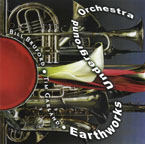 Earthworks
Underground Orchestra Earthworks
Underground Orchestra
Summerfold Records
By Tom Ineck
Since its inception in 1987, Bill Bruford’s Earthworks ensemble
has consisted of a tight-knit quartet driven by its famous
drummer, a prog-rock alumnus of Yes and King Crimson. But for
its ninth release, Bruford and saxophonist Tim Garland expanded
the outfit to nine pieces, dubbing it the Earthworks Underground
Orchestra, based on Garland’s London-based Dean Street
Underground Orchestra.
The
big-band debut, recorded live at The Iridium Jazz Club in New
York City in December 2004, was released last year. Along with
co-leaders Bruford and Garland (who plays tenor and soprano
saxes, flute and bass clarinet), the band also includes Jon
Owens and Alex Sipiagin on trumpets, Rock Ciccarone on trombone,
Chris Karlic on baritone sax and flute, Steve Wilson on alto and
soprano saxes and flute, Henry Hey on piano, and Mike Pope on
electric and acoustic basses. Trombonist Robin Eubanks sits in
on two tracks.
Although the material is largely a familiar sampling from
Earthworks’ repertoire, these eight tunes have been given new
heft with Garland’s arrangements for nonet, and the energetic
performances are exhilarating. With seven horns and a rhythm
section, the Earthworks Underground Orchestra combines jazz
fusion punch with the classic sound of a brass chorale.
Highlights include “Speaking in Wooden Tongues” and the rhythmic
tour de force “Footloose and Fancy Free,” which features bravura
solos by Garland on tenor sax, Eubanks on trombone, Hey on piano
and Bruford on drums. From the band’s early years come the
jaunty opener “Libreville,” the moody “Up North” and the
gorgeous ballad “It Needn’t End in Tears,” written by former
Earthworks member Iain Ballamy. Of more recent vintage are
Garland’s Latin-tinged “Baja del Sol” and Bruford’s 13-minute
extravaganza that closes the recording, “The Wooden Man Sings,
and the Stone Woman Dances.”
In
its maiden voyage, the Earthworks Underground Orchestra retains
the distinctive edge and sound of its original British quartet,
a tribute to Garland’s arrangements and the playing skills of
the overwhelmingly American musicians.
A
major fan of Earthworks since its first LP release, I highly
anticipated this recording and made plans to travel to NYC for
the sessions at the Iridium. Weather prevented me from flying,
but this 70-minute document is the next best thing to being
there. Here’s hoping that Earthworks continues to develop its
trail-blazing sound for another 20 years.
top |
|
|
|
MISHA TSIGANOV
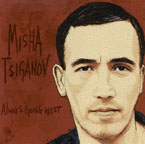 Always
Going West Always
Going West
Misha Tsiganov Records
By Tom Ineck
In
many ways, conguero and bandleader par excellence Norman Hedman
gave pianist Misha Tsiganov the opportunity to realize a dream
of playing jazz in America. Tsiganov took over the piano chair
in Hedman’s band, Tropique, in the late ‘90s, and has been
making musical advances ever since.
Tsiganov’s latest advance is “Always Going West,” a
forward-looking session combining bop and Latin influences with
tasteful execution. “Anthony,” dedicated to legendary drummer
Tony Williams, leaps from the starting gate with fiery bop
insistence, while “Another Rainy Day” reclines in a tempo
suitable for that titular rainy day.
“Roller Coaster” rises and falls with precipitous extremes,
guided by the steady drumming of Gene Jackson. The gorgeous
“Waltz for Olena” features some lovely bass work by Boris Koziov.
Alex Sipiagin’s virtuosic flights on trumpet and flugelhorn are
elements essential to the record’s varying moods, including the
title track’s relaxed Latin groove, where the flugelhorn soars.
Tsiganov pays homage to the late, great pianist Kenny Kirkland
with the searching, mid-tempo bopper “Say Where You’ve Gone,” on
which Sipiagin again plays a pivotal role. It is the leader,
however, who drives the piece with his flashy keyboard
technique. “Gone From My Mind” is the closing ballad, with
Tsiganov and Sipiagin stating the melody in tandem.
Throughout this recording, perhaps most striking is Tsiganov’s
generosity with his musical colleagues. He plays with admirable
restraint and subtlety, while giving the others plenty of time
and space to express their own interpretations of his
compositions. Jackson’s drums are especially prominent.
Of
the nine tracks, all are written and arranged by Tsiganov,
except the memorable Russian folk melody “Dark Eyes.” A
three-minute percussion barrage by Samuel Torres introduces the
full band version of “Dark Eyes,” a brooding arrangement that
finally releases into a wonderful keyboard exploration by
Tsiganov, with powerful support by Jackson on the drum kit. This
is not his father’s “Ochi Chiornie.”
top |
|
|
|
JIM McNEELY-KELLY SILL-JOEL SPENCER
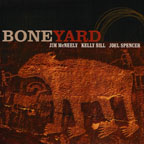 Boneyard Boneyard
Origin Records
By Butch Berman
I
was an only child born in Peoria, Ill., just a couple of stones’
throw to Chicago, before we moved to Lincoln when I was one
year old. My dad worked for my mom’s family, selling jewelry and
buying clothes for their store. He’d go to the market in New
York semi-annually and fly to meet my mother and me in Chicago
for our annual summer vacation. She and I would take the train
to rendezvous there. When I was 10 and very much into baseball,
they took me to see the White Sox and the Cubs back-to-back one
weekend. I was thrilled most by seeing two of the best
shortstops in the big leagues over those two days. Comiskey Park
held Luis Aparacio and Wrigley Field was home to Ernie Banks.
I
also got to go to a great club called Mr. Kelly’s that year. I
heard comic Jackie Mason one night and got my first taste of
big-city jazz hearing Erroll Garner the next. Wow, baseball and
jazz…I was hooked for life.
Move ahead nearly half a century. I’m sitting here reviewing
another wonderful piano player from Chicago named Jim McNeely
just a weekend away from opening day (sorry, Cubbie fans, but
I’ve been a SF Giants devotee since the mid 1980s) and listening
to a marvelous new CD called “Boneyard,” which features a great
McNeely tune called “Ernie Banks.” Boneyard is a creek
that runs through Champaign, Ill., which spawned a jazz scene
that has thrived since the ‘50s.
Jim
jumped in during the 1970s, and around that time met up with a
now-legendary rhythm section consisting of Kelly Sill on bass
and drummer Joel Spencer. These cats don’t play together on a
regular basis, but after 35 years of gigging, their foundation
is rock solid, and is truly one of the best jazz trios in the
biz when engaged at a gig or a superb recording session like
this one.
My
wife, Grace, and I honeymooned in the Windy City five years ago
and caught, and met, Kelly and Joel at a jazz steakhouse in
Evanston, a suburb of Chicago, backing another pianist. They
were tight and terrific, as expected. I got to enjoy Jim’s
classic chops when he was performing at a jazz festival in
Kansas. When Origin Records, one of my fave
jazz labels out there, sent me this CD, I couldn’t wait to put
it on and hear these monsters blow. “Boneyard” is a four-star,
sum-of-the-parts creation that not only should make Chi-town
proud of its players, but jazz itself. This is really one nice
piece of work.
Kurt Weill’s “Speak Low” kicks off the album with a bang. Nine
killer tracks featuring the works of Diz,
Brubeck and Wayne Shorter all make it big time, as well as
compositions of Jim and Kelly—of course, “Ernie Banks” getting
me off the most. Ah yes, baseball and jazz. Credit this talented
threesome with extra base hits throughout. Cheer on your teams
of choice, and rah, rah, rah for this special, all-star team of
Jim McNeely, Kelly Sill and Joel Spencer. “Boneyard” is, without
a doubt, a bases-loaded homer. Play Jazz, play ball.
top |
|
|
|
ED NEUMEISTER QUARTET
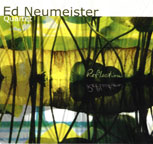 Reflection Reflection
ArtistShare Records
By Butch Berman
Jazz is created from many entities—heartfelt and soulful,
emotionally charged, cerebrally intense, scholarly, and if
you’re so guided…spiritually inspired.
I’ve never met Ed Neumeister,
although we share many friends in the jazz community. Upon the
first sit-down listening to his recent expression of
brilliance—“Reflection”—I was immediately drawn to its beauty,
sadness, charm…yet ever so a thinking man’s jazz of much
substance. On this release, recorded in Vienna in 2006, trombone
master Neumeister truly paints aural
visions of deep feelings with his gifts and exquisite
collaborations with his astute band mates, who share like minds
and compositions.
Let
me introduce you to this kinetic ensemble of fine
musicians—Fritz Pauer at the piano,
Drew Gress on the bass and John
Hollenbeck on drums join trombonist
Neumeister to take you on an
hour-plus excursion that will capture all of your senses.
Reflection, indeed. This is beautiful, heady stuff, crafted in a
variety of key changes, textures and wondrous hues that gently
transport you to a magical place that touches you inside.
It
has some of the best production work I’ve enjoyed in a long
time, especially the gorgeous, rich bass sound Drew
Gress lays down. And, how
wonderfully it was recorded—the drums, too. Hollenbeck’s
amazing, and the constant, clever interplay throughout, between
the horn and piano, is simply enchanting. I’ve never heard a
trombone sing, cry, and wail in the manner that
Neumeister has mastered.
This CD is a work of art that jazz itself can be very proud of.
It’s definitely in my top 10 list for 2006-7. Reflect on this
review, then pick up “Reflection”
through ArtistShare Records today.
top |
|
|
|
RUSS LONG
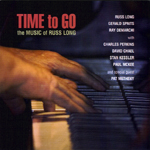 Time
to Go: The Music of Russ Long Time
to Go: The Music of Russ Long
Russ Long Records
By Tom Ineck
The
rare talent and wry comic genius of Kansas City pianist and
vocalist Russ Long are legendary among his many friends, fans
and musical cohorts. But until recently much of his extensive
songbook has been undocumented and virtually unknown to the
public.
“Time to Go: The Music of Russ Long” corrects that omission in
style, with 14 Long compositions performed anew by an ensemble
consisting of stellar KC musicians. The Berman Music
Foundation helped make this project possible with financial
support, at the urging of longtime Long friend, bassist and BMF
consultant Gerald Spaits.
In
the true spirit of collaboration, Long and Spaits chose the
tunes that would be included. Spaits transcribed much of the
music and the two co-wrote the arrangements. Spaits then hired
the musicians that could best interpret the charts and wrote out
their parts. The result is a stunning recording of original
music, lovingly rendered by a septet of compatible craftsmen. At
the core is the threesome of Long, Spaits and drummer Ray
DeMarchi, who have performed as a trio for more than 20 years
and who were featured several years ago on the BMF-produced CD
“Never Let Me Go.”
But
what makes this session so memorable is the expansive sound of
the larger ensemble, with saxophonists Charles Perkins and David
Chael, trumpeter Stan Kessler and trombonist Paul McKee. The
brass voicing is warm and embracing, giving the sound an
intimate feel that enhances the personal nature of this tribute.
Needless to say, the ensemble’s performance is flawless and the
overall sound is pristine.
In
his modest manner, Long downplays his ability at the keyboard in
a brief introductory statement, saying that it wasn’t until the
1980s he knew he was a piano player. Judging by the wealth of
original compositions here, he was developing as a distinctive
tunesmith long before that.
“Woodland Park” is a snappy little opener that has the brass
moving in close formation, with urgent emphasis by Kessler on
trumpet. Perkins opens “Serenade” with a lovely bass clarinet
statement, giving the tune an appropriately lazy, relaxed
quality. McKee expands on that mood before handing it off to
Spaits. Long proves his keyboard mastery with typically subtle
contributions.
The
title track returns to an easy-swinging medium tempo, while
“Meatloaf” picks up the pace with a bluesy gusto and solos by
McKee, Chael and Kessler, who trades fiery fours with DeMarchi.
Dark, minor chords introduce “E-Train” in bluesy brass harmony
before opening into a more conventional blues pattern, perfectly
expressed in solos by Perkins, McKee, Chael and Long.
In
an obvious tip of the hat to Miles Davis, “s’Miles” is a
hard-charging bop tune with excellent solo takes by Perkins on
flute, Kessler, Chael and McKee. “Etude” is a moody classically
influenced piece pairing piano and trombone. “Shoemaker” and
“Can City” are both swinging uptempo tunes, which may cause some
confusion for the listener. The titles were inadvertently
transposed on the CD.
“Spider” has a loping, aptly spider-like movement with an
interesting, descending chord progression. Another bluesy
mid-tempo offering is “I Don’t Care Who,” with Chael, McKee and
Perkins and Spaits delivering relaxed but forceful solos and
Long comping with casual aplomb. Perhaps the most profoundly
moving piece is also the most simple, a two-minute brass chorale
called “Parallel,” with horns stating the chord progression in
harmony and the rhythm section comping gently.
But
what is a Russ Long recording without his unmistakable voice? As
an apt closer, he treats us to a brief rendition of Cole Porter
classic “You’d Be So Nice to Come Home To.”
The
wild card here is guitarist Pat Metheny’s solo acoustic
rendition of Long’s gorgeous ballad “Never Was Love,” a longtime
favorite of Metheny’s that he recorded without a chart—by
memory. Metheny also contributed liner notes praising Long for
his lasting influence more than 30 years ago, when the
guitarist—still a teen—played in Long’s organ combo. “One of the
highlights of my life as a musician,” Metheny writes, “has been
the chance to play with one of Kansas City’s greatest musicians
ever—Russ Long.”
Spaits reports that the ensemble recordings for “Time to Go”
were completed in just two sessions, with most tunes captured in
the first take. Long’s tasteful choice of comping chords
throughout the session is a testament to his bandleader’s
unerring ear, much like that other KC legend, Count Basie.
Unusual in today’s world of extended jams—that too often go
nowhere—six of the 15 tunes clock in at under four minutes, all
well-polished and shimmering gems.
top |
|
|
|
BUCK HILL
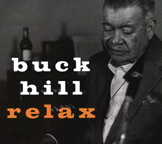 Relax Relax
Severn Records
By Tom Ineck
As
he approaches 80, Roger “Buck” Hill could be forgiven for
slowing the pace a bit. But no, the Washington, D.C.-based tenor
saxophonist insists on swinging with gusto on his latest effort.
A blue-collar worker who kept a day job as mail carrier
throughout most of his jazz career, Hill still knows the value
of good, hard work.
“Relax” gets its title from the second track, a suitably relaxed
mid-tempo swinger. For Hill, however, the blues are never far
away. The blues feel is enhanced by John Ozment on Hammond
organ, guitarist Paul Pieper and drummer Jerry Jones, creating
the classic soul jazz setting for Hill’s muscular tenor.
The
burner “RH Blues” opens the CD with a charging reminder of
Hill’s roots. “Little Bossa” gets everyone involved, beginning
with Ozment, then Hill and finally Pieper, while the bossa beat
keeps Jones on his toes.
Miles Davis is well represented here, with three of his tunes
programmed consecutively: the exotic excursion “Flamenco
Sketches,” the bluesy “Prancing” and the boppish “Milestones.”
Hill also shows his ability to emote on the ballad standard “Old
Folks.” His intonation and breath control, where age in horn
players usually starts to show, remains strong even in the upper
ranges. The Hill original “Sad Ones” closes the recording on a
wistful note.
Ozment, Pieper and Jones admirably back Hill’s brawny tenor
blasts and add their own touches to an all-around satisfying
listen. As he ably ranges the Hammond keyboards and bass foot
pedals, Ozment is especially effective in helping to establish
the easy swinging groove that dominates the session.
That Hill himself wrote half the tunes is a testament to his
involvement in this project, his first recording as a leader in
almost 15 years. A welcome return to the spotlight, indeed!
top |
|
|
|
THE ROGER KELLAWAY TRIO
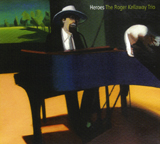 Heroes Heroes
IPO Recordings
By Tom Ineck
Pianist Roger Kellaway, explaining the magic of Oscar Peterson’s
early drummerless trios, describes it as “the will to swing.”
Likewise, Kellaway’s latest release on IPO Recordings, with
guitarist Bruce Forman and bassist Dan Lutz, expresses that same
will to swing—a propulsive, often breathtaking, always
rhythmically charged performance that leaves the listener
thoroughly satisfied—and astounded.
The
threesome is a cohesive team, clinging to the challenging tempos
with faultless technique and devil-take-the-hindmost bravado.
The collective interplay often is extended—three of the 10
tracks are over eight minutes—and the mood is alternately breezy
and intense. It seems Kellaway, Forman and Lutz may be capable
of anything, from the blues swagger of “Killer Joe” to the
driving “Cotton Tail” to the relaxed “I Was Doing All Right” to
the sublime “Nuages.”
In
terms of repertoire, there are few surprises here and only one
original tune. Most of the tunes are taken from Peterson’s 1950s
recordings. It is the camaraderie and prodigious playing of
Kellaway and his fellow-travelers that elevate this set far
above the ordinary. “Night Train,” for example, captures all the
bluesy bluster of the Jimmy Forrest classic, but offsets the
bombast with lyrical stride piano passages that cleverly avoid
cliché. After Kellaway’s stately solo introduction, Forman picks
up the mood with dazzling guitar runs as Lutz keeps a steady
walking bass line before taking a brilliant solo of his own.
Finally, the trio blazes a three-way trail to the finish line
with call-and-answer precision.
Kellaway’s aptly titled “I’m Smiling Again” is a brief, but
joyful romp with Lutz taking the lead melody line in a lyrical
style reminiscent of Ray Brown. Forman keeps the rhythm chugging
along as Kellaway adds deft flourishes. In reharmonizing
“Midnight Sun,” the trio has created a new interpretation, with
cascading chords and a wistful Latin tinge. For less emotionally
charged material, Kellaway and company turn to “Moten Swing” and
the furiously paced and fearlessly executed “52nd
Street Theme.”
After an unusually long pause between tracks, the trio returns
with its grand finale, Oscar Peterson’s gospel-tinged paean
“Hymn to Freedom.” Kellaway begins with mournful, blues-drenched
chords and leaping arpeggios, building slowly as Forman and Lutz
enter more than half-way through the eight-minute piece. They
drop out again, as Kellaway takes it home with an exquisite
piano coda.
It
simply doesn’t get any better than this.
top |
|
|
|
SONNY ROLLINS
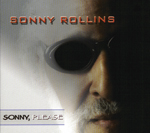 Sonny,
Please Sonny,
Please
Doxy Records
By Tom Ineck
At
75, Sonny Rollins entered a new phase in his amazing six-decade
career in the forefront of modern, post-bop jazz. He inaugurated
his own Doxy label, and its first release is a humdinger.
“Sonny, Please,” named for a term of endearment used frequently
by his late wife, Lucille, is simultaneously a reaffirmation of
his staying power and a confident step forward. To sustain his
comfort level, Rollins has gathered around him a
well-established group of compatible musicians—nephew Clifton
Anderson on trombone, Bobby Broom on guitar, longtime comrade
Bob Cranshaw on bass, Steve Jordan on drums and Kimati Dinizulu
on percussion. Rollins penned four of the seven tunes in this
hour-long set.
The
lead-off title track is a brash, bold venture that perfectly
illustrates the brawny Rollins sound, still as robust as ever.
Noel Coward’s rarely heard “Someday I’ll Find You” proves a
lyrical vehicle for Rollins’ waltz-time proclivities, with
especially tasteful contributions by Broom and Cranshaw.
“Nishi” swings with blues power as Rollins digs deep into his
bag of sly references, Jordan delivers a crackling drum solo,
and Anderson follows with a muted statement. Rollins faithfully
renders the melody to “Stairway to the Stars” before
deconstructing it in typical fashion. “Remembering Tommy” is a
gently swinging tribute to the late pianist and frequent Rollins
collaborator Tommy Flanagan.
Rollins returns to the dance floor in waltz time with Drigo’s
tender “Serenade (Love Serenade).” In stretching it to more than
eight minutes, Rollins creates a panoply of variations on the
theme. With the closer, “Park Palace Parade,” he again dabbles
in one of his favorite rhythmic genres, the calypso sounds of
Trinidad.
“Sonny, Please” has been justly nominated for a Grammy Award in
the category of best jazz instrumental album. If anyone deserves
continued success and critical accolades, it is Sonny Rollins.
top |
|
|
|
THE EDDIE DANIELS QUARTET
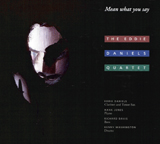 Mean
What You Say Mean
What You Say
IPO Recordings
By Tom Ineck
Eddie Daniels, like another inveterate swinger, Ken Peplowski,
is equally adept on the tenor saxophone and the clarinet. On
2005’s “Mean What You Say,” Daniels showcases both instruments
in a solid repertoire, largely consisting of standards, and
accompanied by a trio of giants—pianist Hank Jones, bassist
Richard Davis and drummer Kenny Washington.
Daniels displays his straight-ahead tenor chops on the opening
title track by the pianist’s late brother, Thad. Switching to
clarinet, he leaps and frolics through “It Had to Be You,”
gently essays Billy Strayhorn’s “Passion Flower” and throws
sparks on the frantic “Nagasaki,” as Jones strides with aplomb
and Washington expertly keeps the hectic pace with brushes.
It’s back to the tenor sax for an absolutely beautiful version
of the popular ballad “My One and Only Love.” Daniels is all
over the horn, exhibiting his trademark burnished tone and deft
fingering. Jones, age 87 at the time of this recording,
contributes a subtly spectacular solo with consummate good
taste.
Daniels and Jones co-penned the three-minute gem, “Why You…,” a
clever and joyful romp for clarinet and piano duo. The easy
swinging, lyrical Ellington tune “Azure,” is the perfect vehicle
for clarinet, with the trio gracefully laying back. Clarinet is
again the lead instrument on a mid-tempo version of Ray Noble’s
“The Touch of Your Lips,” decorated by Jones’ stately keyboard
contributions.
The
tempo swings mightily on “You and the Night and the Music,”
another showcase for Daniels’ tenor excursions and Jones’
stylish pianistics, with precision, stop-time trades with
Washington. The clarinet leaps back in for “I’m Getting
Sentimental over You” and Charlie Parker’s rumba-tinged tune “My
Little Suede Shoes.” Acting as the closing bookend on the
recording, Daniels’ brawny tenor returns one more time for an
uptempo take on “How Deep is the Ocean,” with another brilliant
solo by Jones.
While billed as The Eddie Daniels Quartet, the ensemble is
immensely influenced by the presence of the masterful Mr. Jones,
a significant contribution that Daniels acknowledges throughout.
Despite more than 20 years difference in their ages, they prove
a musically compatible team in a memorably executed session.
top |
|
|
|
MINGUS BIG BAND
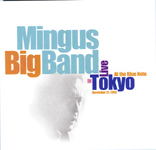 Live
in Tokyo Live
in Tokyo
Sue Mingus Music/Sunnyside
By Tom Ineck
Formed 15 years ago to pay tribute to the music of the late,
great composer, bass player and bandleader Charles Mingus, the
Mingus Big Band continues to honor its namesake with a tough,
aggressive and bluesy sound on “Live in Tokyo.” Recorded on New
Year’s Eve 2005 at the Blue Note, it is the eighth release since
the band’s recording debut in 1993 and the first on the Sue
Mingus Music label, under the auspices of the composer’s widow.
Herein, the 14-piece ensemble reels off eight tunes by the
master, including the hard-charging opener “Wham Bam,” a 50s
vintage piece arranged by baritone saxophonist Ronnie Cuber.
“Opus Four,” from the early ‘70s, is a typically complex Mingus
chart, with stop-time shifts segueing into solo statements by
trombonist Frank Lacy, trumpeter Eddie Henderson and pianist
Dave Kikoski. Again delving into the 1950s Mingus songbook, the
band presents Steve Slagle’s arrangement of the ballad “Celia”
as a vehicle for alto saxophonist Craig Handy.
Cuber also contributed the arrangement for “Bird Calls,” which
Mingus wrote in the 1950s as a bop tribute to Charlie “Bird”
Parker. Beginning with band members vocally and instrumentally
mimicking the tweets and squawks of tropical birds, it kicks
into high gear with successive sax solos by Cuber, Seamus Blake
on tenor, Handy on alto and Abraham Burton on alto. They trade
in furious rotation, raising the ante with every round. Kikoski
eventually dives into the fray for a stunning piano solo.
“Meditations” is a 10-minute tour de force of constantly
shifting tempos and time signatures that perfectly exhibits the
ensemble’s precision and dedication with beautiful and haunting
brass voicing. It is fitting that the soulful “Prayer for
Passive Resistance,” composed by Mingus in the ‘60s, was the
last piece of music arranged by longtime band member and tenor
saxophonist John Stubblefield, who died in July 2005. Wayne
Escoffery masterfully takes the helm at tenor in Stubblefield’s
absence.
Despite the implications of its gloomy title, “Free Cell Block
F” is an upbeat tune featuring a sprightly flute solo by Handy
and equally expressive statements by trombonists Conrad Herwig
and Lacy and baritone saxophonist Cuber. Finally, Lacy takes the
pulpit as preacher on the hell-raising “Ecclusiastics,” setting
the stage for tenor sax workouts by Escoffery and Blake.
Drummer Johnathan Blake drives the entire proceedings with
forceful precision. His powerful attack effectively drives the
large ensemble. It is comforting for Mingus fans to know that
more than 27 years after the composer’s death in 1979 his music
continues to inspire faithfully fiery interpretations such as
those captured by the superb musicians on “Live in Tokyo.” Long
live Mingus!
top |
|
|
|
ROYCE CAMPBELL
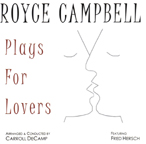 Plays
for Lovers Plays
for Lovers
Moon Cycle Records
By Tom Ineck
A
prolific, but underappreciated, mainstream jazz guitarist, Royce
Campbell has released some 15 recordings of his own since his
debut in 1990, most of them on small, independent labels,
including five on his own Moon Cycle Records.
Originally released in 1999 under the title “Waltz for Debby” on
the Japanese King Records label, “Plays for Lovers” is exactly
the lush, romantic outing you would expect from its title. In
addition to well-regarded romanticist Fred Hersch at the piano,
the session boasts the great bassist Lynn Seaton, drummer Mark
Wolfey and a classical ensemble of strings, brass and woodwinds
that enhances the mood without intruding on the superb
craftsmanship of the principal players.
The
repertoire contains many of the usual suspects for a collection
of romantic melodies—the gentle bossa nova “Estate,” the
evergreen “Body and Soul,” Bill Evans classic “Waltz for Debby,”
Johnny Mandel’s “A Time for Love,” Cole Porter’s “I Concentrate
on You,” the well-worn standard “But Beautiful,” and the Gordon
Jenkins ballad “This Is All I Ask,” famously covered by Tony
Bennett, Nat Cole, Perry Como, and Frank Sinatra.
Tempos vary slightly from ballads to mid-tempo swingers, but
always guided by Campbell’s light touch on the fretboard. “I
Concentrate on You,” for example, swings for over nine minutes,
while affording Campbell, Hersch and Seaton plenty of room to
express themselves in solos and in trades with Wolfey. Most of
the nine tracks average about five minutes each.
Campbell’s own compositions, “Sounds of Love” and “I Feel like
We Have Met Before,” are ideally suited for the occasion. A
gorgeous violin solo by Cathy Morris introduces the latter,
segueing into a Hersch statement before the pianist turns it
over to Campbell for a full statement of the theme, with Morris
returning for a tender summation.
The
yearning “This Is All I Ask” is a delightful showcase for
Campbell’s melodic talents and lyrical phrasing, guaranteed to
make two lovers of friends. In fact, “Royce Campbell Plays for
Lovers” is the perfect soundtrack for a cold winter’s night in
front of the fire with someone near and dear.
top |
|
|
|
ANDREW VOGT
 Action
Plan Action
Plan
Drew’s Blues Records
By Butch Berman
I’ve known Andrew Vogt for more than a decade, and even in his
early 20s he gave the appearance of an “action man.” Laid back,
but hyped; a little drifty, but extremely focused; sensitive,
yet intense. You knew he was headed somewhere, hence a plan.
He
left Nebraska, woodshedded on the cruise ships, overcame a
health setback, moved to Colorado, gigged a lot, recorded with
the likes of Jason Hollar, and
now—finally—put out a record under his own moniker. “Action
Plan,” indeed.
It’s a nifty little CD packed with a bunch of great tunes penned
by Andrew and played to perfection. It took me to the zone upon
first listening, and, like an onion, it reveals all sorts of
cool shit within the grooves upon repeated listening. I seem to
like it more each time, and I dug it a whole bunch from the
first sit-down.
Oh
yeah…Andrew plays sax, all of ‘em, and a mean clarinet as well.
This cat blows with a sound, clarity and delivery of a much
older, more seasoned player. We both share a love for the late,
great Art Pepper, and his spirit shines through his astounding
reed work. The cleverly titled “Art Peppershaker” showcases his
fondness for Art, yet his style is all Andrew Vogt.
Andrew’s backed by a fine group of presumably Colorado pros
featuring the tasteful touch of Mark
Sloniker on the piano. Eric Applegate holds down the bass
work tightly, along with drummer Mark
Raynes, who combine to be a most able rhythm section.
Rich Chiaraluce handles the other
sax chair along with Kevin Whalen on trumpet, creating a superb
frontline with Vogt. The double-clarinet performance by Andrew
and Rick on “Fry Tin” is terrific. Andrew’s solo experience on
the piano/sax duo “Never No Not Far” was stirring and simply
lovely, as was Sloniker’s fluid
accompaniment.
“Action Plan” was recorded at Notable Fine Audio in Denver by
Colin Bricker, who created a most decent environment, capturing
a wonderful, true jazz sound by all involved. Jeff
Blume’s neat photo work and layout
make “Action Plan” a must-have for 2007. Plan to take immediate
action and go out and get it. Where? Go to www.drewsblues.com
for all the info and…all that jazz.
top |
|
|
|
JAY LAWRENCE TRIO
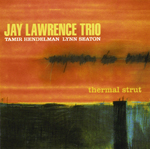 Thermal
Strut Thermal
Strut
OA2 Records
By Butch Berman
I
get tons of recordings for review, and probably would not have
gotten to this fine product if I hadn’t noticed two names that
rang loud bells. I first encountered the master bassist Lynn
Seaton while attending a Jamie Aebersold
jazz clinic near Chicago several years ago. He’s an outgoing guy
with a heart as big as his body, plus an immense talent to boot.
His supple playing has astounded me ever since.
I
heard and met pianist Tamir
Hendelman with the Jeff Hamilton
Trio when I was working the now-defunct Topeka Jazz Festival in
Kansas and admired his chops greatly. The drummer and leader of
this group and session is Jay Lawrence. I had not been graced by
his presence, nor heard his resounding, percussive style before.
When you put these three cats together, look out. “Thermal
Strut” is as incendiary as its title.
All
the up-tempo tunes sizzle. Nobody can out do Cozy Cole on “Topsy,”
but these top-notch players take it to another place that still
captures the original magic of the “cozy” one. I was most blown
away by their fab arrangement of The
Beatles’ “You Can’t Do That” that almost romps and stomps itself
off the CD player. It swings THAT hard!
No
clunkers anywhere on this disc, as this album’s track list reads
like a great night out on the town to hear really good jazz. A
lovely take on Jimmy Rowles’
“Peacocks” ends this excursion on a sweet note, and nobody does
Slam Stewart like Lynn Seaton, which kicks off this splendid
piece of work on the opening title track. Yup…”Thermal Strut.”
It’ll get you hot, and make you want to dance. Indeed.
top |
|
|
|

 Live
at the Village Vanguard
Live
at the Village Vanguard Panorama
Panorama Latest
Outlook
Latest
Outlook Flurry
Flurry Ed
Reed Sings Love Stories
Ed
Reed Sings Love Stories Song
Garden
Song
Garden In
the Zone
In
the Zone “Live”
at Harlings Upstairs
“Live”
at Harlings Upstairs Down
the Middle
Down
the Middle Next
to You
Next
to You A
Spirit Free: Abbey Lincoln Songbook
A
Spirit Free: Abbey Lincoln Songbook Take
Your Clothes off When You Dance
Take
Your Clothes off When You Dance Half
the Perfect World
Half
the Perfect World Family
First
Family
First Brownstone
Brownstone Earthworks
Underground Orchestra
Earthworks
Underground Orchestra Always
Going West
Always
Going West Boneyard
Boneyard Reflection
Reflection Time
to Go: The Music of Russ Long
Time
to Go: The Music of Russ Long Relax
Relax Heroes
Heroes Sonny,
Please
Sonny,
Please Mean
What You Say
Mean
What You Say Live
in Tokyo
Live
in Tokyo Plays
for Lovers
Plays
for Lovers Action
Plan
Action
Plan Thermal
Strut
Thermal
Strut